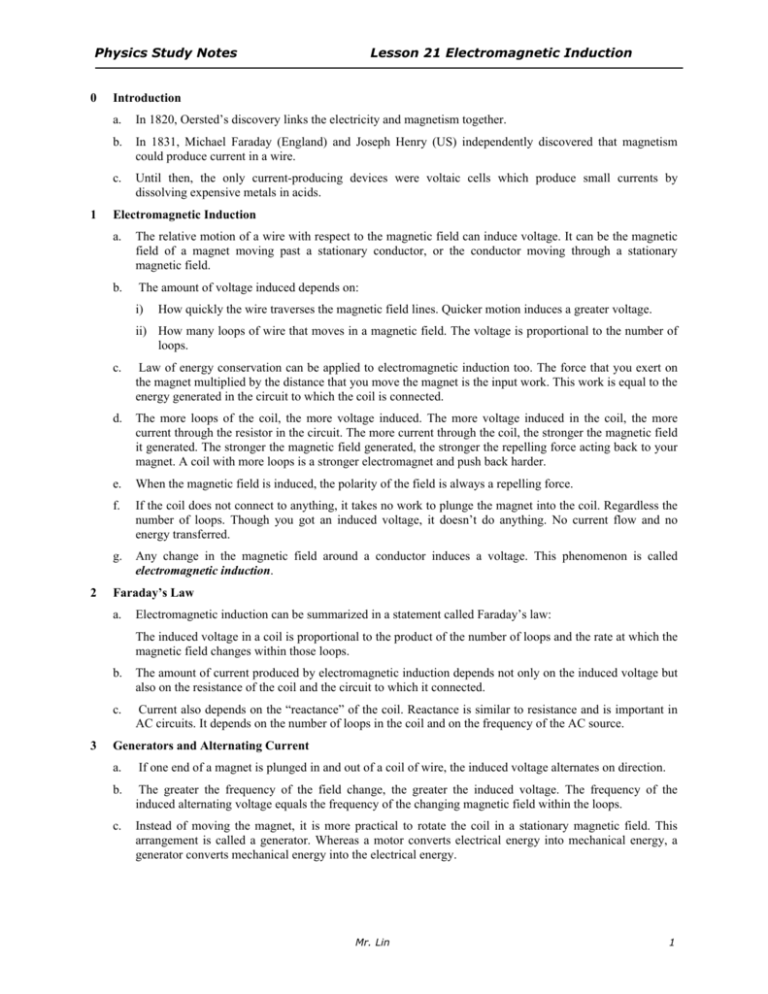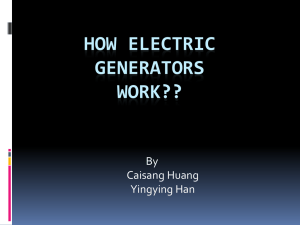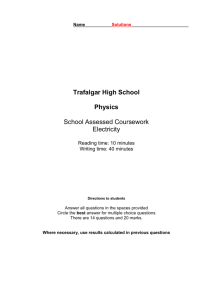Study Notes Lesson 21 Electromagnetic Induction
advertisement

Physics Study Notes 0 1 Lesson 21 Electromagnetic Induction Introduction a. In 1820, Oersted’s discovery links the electricity and magnetism together. b. In 1831, Michael Faraday (England) and Joseph Henry (US) independently discovered that magnetism could produce current in a wire. c. Until then, the only current-producing devices were voltaic cells which produce small currents by dissolving expensive metals in acids. Electromagnetic Induction a. The relative motion of a wire with respect to the magnetic field can induce voltage. It can be the magnetic field of a magnet moving past a stationary conductor, or the conductor moving through a stationary magnetic field. b. The amount of voltage induced depends on: i) How quickly the wire traverses the magnetic field lines. Quicker motion induces a greater voltage. ii) How many loops of wire that moves in a magnetic field. The voltage is proportional to the number of loops. 2 c. Law of energy conservation can be applied to electromagnetic induction too. The force that you exert on the magnet multiplied by the distance that you move the magnet is the input work. This work is equal to the energy generated in the circuit to which the coil is connected. d. The more loops of the coil, the more voltage induced. The more voltage induced in the coil, the more current through the resistor in the circuit. The more current through the coil, the stronger the magnetic field it generated. The stronger the magnetic field generated, the stronger the repelling force acting back to your magnet. A coil with more loops is a stronger electromagnet and push back harder. e. When the magnetic field is induced, the polarity of the field is always a repelling force. f. If the coil does not connect to anything, it takes no work to plunge the magnet into the coil. Regardless the number of loops. Though you got an induced voltage, it doesn’t do anything. No current flow and no energy transferred. g. Any change in the magnetic field around a conductor induces a voltage. This phenomenon is called electromagnetic induction. Faraday’s Law a. Electromagnetic induction can be summarized in a statement called Faraday’s law: The induced voltage in a coil is proportional to the product of the number of loops and the rate at which the magnetic field changes within those loops. 3 b. The amount of current produced by electromagnetic induction depends not only on the induced voltage but also on the resistance of the coil and the circuit to which it connected. c. Current also depends on the “reactance” of the coil. Reactance is similar to resistance and is important in AC circuits. It depends on the number of loops in the coil and on the frequency of the AC source. Generators and Alternating Current a. If one end of a magnet is plunged in and out of a coil of wire, the induced voltage alternates on direction. b. The greater the frequency of the field change, the greater the induced voltage. The frequency of the induced alternating voltage equals the frequency of the changing magnetic field within the loops. c. Instead of moving the magnet, it is more practical to rotate the coil in a stationary magnetic field. This arrangement is called a generator. Whereas a motor converts electrical energy into mechanical energy, a generator converts mechanical energy into the electrical energy. Mr. Lin 1 Physics Study Notes d. Lesson 21 Electromagnetic Induction When the loop of wire is rotating in the magnetic field, there is a change in the number of magnetic field lines within the loop. As the loop rotates, the magnitude and direction of the induced voltage and current change. One complete rotation of the loop produces on complete cycle in voltage and current. Magnetic Field Lines Magnetic Field Voltage Current 4 e. The direction of the current induced can be decided by the Fleming’s right hand generator rule: If you point your right forefinger in the direction of the magnetic field, and your thumb will point in the direction of the motion of wire, then your second finger is the direction of the induced current flow. f. The voltage induced by the generator alternates, and the current produced is alternating current (AC). The standard alternating current is 60 Hz. g. The generator used in the power plants are much more complicated. Huge coil are wrapped on an iron core. The armature is connected externally to an assembly of paddle wheels called turbine. Energy from wind or falling water can be used to produce rotation of the turbine. Most of the commercial generators are driven by moving steam. Usually a fossil fuel or nuclear fuel is used as the energy source of the steam. The generator converts most of the mechanical energy to electrical energy. h. The electricity is a form of energy instead of a source of the energy. Motor and Generator Comparison a. 5 Force Both of them are based on the same fact: Moving charges experience a force that is perpendicular to their motion and the magnetic field they traverse. We will call the deflected wire the motor effect and the law of induction the generator effect. Transformer a. Consider a pair of coils, side by side. One of them connects to a power source (called primary/ input coil), and the other connect to a galvanometer (called secondary/output coil). b. When there is an on/off switching in the primary coil, the change of magnetic field that builds up around the primary and extends into the secondary coil is sensed by the secondary coil. These changes of magnetic field intensity at the secondary induce voltage in the secondary, in accord with Faraday’s law. c. If an iron core is inserted into the primary and secondary coil. The alignment of magnetic domains in the iron will intensify the magnetic field. The magnetic field is also concentrated in the core, so the secondary intercepts more of the filed change. d. If AC is used to power the primary, the rate of change in the primary is equal to the frequency of the alternating current. e. If iron core forms a complete loop to guide all magnetic field lines through the secondary. All magnetic lines within the primary are intercepted by the secondary. f. The primary and second coil may have different number of turns. If secondary has n (n > 1, n = 1 or n < 1) times the turns than the primary, it will induce n times more/equal/less voltage. g. When there is greater number of turns on secondary than on primary, the output voltage is higher than the input one, the transformer is called the step-up transformer. When there is less number of turns on secondary than on primary, the output voltage is lower than the input one, the transformer is called the stepdown transformer. Mr. Lin 2 Physics Study Notes h. Lesson 21 Electromagnetic Induction The relationship between primary and secondary voltages with respect to the relative number of turns is (primary voltage)/(number of primary turns) = (secondary voltage)/(number of secondary turns) i. The transformer transfers energy from one coil to the other. The rate of energy is transferred is the power. Based on the conservation of energy, if the slight power losses due to heating of the core are neglected, and because power P = IV, so then power into primary = power out of secondary 6 7 8 (IV)primary = (IV)secondary Power Transmission a. Electricity sold today is in the form of AC because the ease with which it can be transformed from one voltage to another. b. Power is transmitted great distances at high voltages and low current. Otherwise it will heat up the wire and cause great energy losses. Power may be carried from power plant to the city at 120,000 V, and stepped down to about 2,200 V in the city, and finally stepped down to 120 V used in the household. c. The far-reaching effect of electromagnetic induction: power transmission from one system of conducting wire to another, radio transmission from transmitter to receiver, energy from sun to Earth. Induction of Electric and Magnetic Field a. Faraday’s law: An electric field is created in any region of space in which a magnetic field is changing with time. The magnitude of the created electric field is proportional to the rate at which the magnetic field changes. The direction of the created electric field is at right angles to the changing magnetic field. b. Maxwell’s law: A magnetic field is created in any region of space in which an electric field is changing with time. The magnitude of the created magnetic field is proportional to the rate at which the electric field changes. The direction of the created magnetic field is at right angles to the changing electric field. c. The symmetry of electric and magnetic field underlies the understanding of electromagnetic waves. Electromagnetic Waves a. Shaking a charge back and forth in empty space will produce electromagnetic waves in space, because the shaking charge can be considered an electric current. A changing magnetic field will surround a changing electric current. A changing magnetic field will create a changing electric field (Faraday’s law). And a changing electric field will create a changing magnetic field (Maxwell’s law). b. An electromagnetic wave is composed of vibrating electric and magnetic fields that regenerate each other. No medium is required. The vibrating fields emanate from the vibrating charge. At any point on the wave, the electric field is perpendicular to the magnetic field, and both are perpendicular to the direction of the motion of the wave. c. For electromagnetic radiation, there is only one speed— the speed of light— no matter what the frequency or wavelength or intensity of the radiation. d. The wave is continuously self-reinforcing. The changing electric field induced a magnetic field. The changing magnetic field acts back to induce a electric field. Maxwell’s equations showed that only one speed can preserve this harmonious balance of fields. That’s the speed of light. Mr. Lin 3






